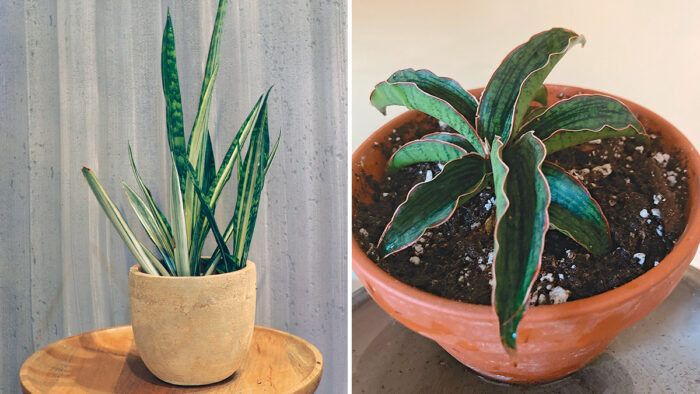
Snake plants (Dracaena spp. and cvs., syn. Sansevieria spp. and cvs., Zones 9–11) are usually discounted in the houseplant world as reliable and reliably dull. But these often-maligned plants so commonly seen in the background of malls and offices can shine as the center of attention. Snake plants are far more diverse than the ubiquitous variegated snake plant (D. trifasciata ‘Laurentii’, Zones 9–11) would have you believe. There are some, like bird’s nest snake plant (D. trifasciata ‘Hahnii’, Zones 9–11), that stay around 6 inches tall, while elephant tusks plant (D. stuckyi, Zones 9–11) and others can reach 8 feet tall. Snake plants take many forms, from grassy clumps to architectural spears, and their foliage comes in many colors. Although they’re relatively easy to care for, you still need to provide them with the proper conditions and maintenance to ensure top performance.
Provide direct or indirect light
Snake plants can tolerate almost any light condition, but they thrive with at least some moderate direct or indirect light. Many are full-sun plants in their native climates, but they can tolerate less light with grace. The less light they get, the slower their already slow growth rate will be. While many snake plants can take direct sun, most variegated varieties prefer filtered light, as they burn more easily than their nonvariegated counterparts.

Be stingy with water and fertilizer
Snake plants are succulents, and they prefer to be left unwatered and untouched for weeks at a time. They will be steady companions over the years with little attention or even repotting. Not much shakes snake plants, but they benefit from an even hand. Make a habit of checking in on your plants every week. Water every two weeks during summer, and fertilize about once a month. In winter, stop fertilizing them altogether, and water once every three to four weeks. Watering should slightly increase with how much sun and heat your plants are exposed to and decrease incrementally as you move them to cooler and shadier locations. These are drought-tolerant plants that do not like to be overwatered; make sure the soil has dried completely before watering again. A pot with a hole and saucer will help ensure proper drainage.
Avoid these common downfalls
Spraying down your snake plants in the shower from time to time (tipping them to the side so as not to leave water sitting in the crux of the leaves) can help get rid of the infrequent pests they may suffer from; alternatively, you can wipe down the leaves. Too much water or inconsistent watering can cause edema, a condition that occurs when plants take up a lot of water suddenly. It causes a corky, bumpy discoloration of the foliage. Too much fertilizer, too much water, and too much abrupt movement from one place to another are the main culprits of unsightly foliage or dead leaf tips. Acclimate your plants slowly to a new lighting situation so as not to burn them. And if you are comfortable, your snake plants should be too; they should never be in situations that are colder than 50°F.
How to Propagate Snake Plants
Many indoor gardeners like rooting snake-plant leaf cuttings in water, leaving them in a clear vessel somewhere light and warm until roots form. I prefer sticking cuttings in soil with rooting hormone because it’s less likely that your cuttings will rot. I then leave them dry for at least a couple of weeks to callus and to begin forming roots before I begin watering with caution and infrequency, making sure to keep them in a warm place. However, this is a time-consuming method that does not ensure a clone of the mother plant. To get new plants that retain the elegant variegation of a variety such as ‘Bantel’s Sensation’, I wait for the mother plant to naturally form pups. I then divide the pups from the mother plant and replant.
Three Unique Varieties for Easy-Care Flair
From classics to new introductions, these cultivars show just some of the incredible diversity of snake plants.

‘Cleopatra’ draws the eye with colorful contrast
D. pethera ‘Cleopatra’ syn. Sansevieria kirkii ‘Cleopatra’, Zones 9–11
‘Cleopatra’ is a low-growing, rosette-forming snake plant with a blue hue to its foliage. It features attractive striations with a redbrown edge around the leaves. This creates a contrast that only accentuates the blue tone of the foliage.

‘Starfish’ is beloved for its unusual form
D. angolensis ‘Starfish’ syn. Sansevieria cylindrica ‘Starfish’, Zones 9–11
This variety grows in a fan of thick sausage-like leaves that will reach no taller than 1 foot. Its unique architectural shape is striking. ‘Starfish’ will slowly form offsets of more fans, making for an impressive mature specimen.

‘Bantel’s Sensation’ features stunning variegation
D. trifasciata ‘Bantel’s Sensation’, Zones 9–11
Also called white snake plant, this is a stiffly erect, highly variegated variety that reaches 2 to 3 feet tall. It’s slow to offset and has become popular for its arrow-straight, narrow leaves.
Elizabeth Werlebird has been growing houseplants for almost twenty years. She’s currently an assistant grower at Shakespeare’s Garden, a nursery in Brookfield, Connecticut.
Illustrations: Savannah Gallagher




















Comments
Log in or create an account to post a comment.
Sign up Log in